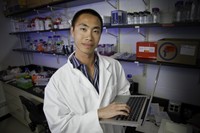CAMDEN — Move over, David Caruso. Rutgers–Camden has a computer
scientist on the case.
For a research project that sounds like it could have been taken
from a CSI script, Desmond Lun, an
associate professor of computer science at Rutgers–Camden, is working with a
team of forensic scientists from Boston University to more accurately analyze
DNA evidence at a crime scene.
Lun has been aw

Desmond Lun's research could change the way DNA evidence is analyzed.
arded a $206,946 grant from the National Institute
of Justice to use computer science to determine the number of people who
contributed to a particular DNA sample.
“In forensic applications, you pick up a DNA sample at a crime scene
and you can use that information to determine whether or not someone was
there,” Lun explains. “But more often than not, you’re getting ‘noisy’ samples
with multiple contributors.”
For example, if one were to try to analyze DNA taken from a desk
in one of Lun’s classrooms, chances are the DNA from all of the people who had
contact with the desk would be in the sample.
“There’s a computational problem with trying to pick out one
individual from that sample,” Lun says. “The way that it is done now
introduces a considerable subjective component that can bias the results of a
trial or not allow an important piece of evidence to be used for conviction.”
DNA can be found in any human cells including blood,
hair, and skin. Lun says he hopes to better determine the likelihood a specific
DNA match occurs.
“If the match could just as easily come from a random
person, then it is not useful evidence,” he explains. “You need a quantitative
answer that expresses how likely the observed match is relative to a completely
random occurrence in a way that allows a layperson, a juror for example, to
accurately assess the weight of the evidence.”
Lun says if he and the researchers are successful in
their work, forensic crime labs could introduce new software into their
analysis procedures.
Part of the project is to develop free software that
crime labs can use to test the new method. If they find it useful, the software
could gradually become incorporated into standard practice.
Lun is also currently working on two other research projects:
altering the genetic makeup of E. coli to produce biodiesel fuel derived from
fatty acids, and making predictions about the behavior of the bacterium that
causes tuberculosis to determine new ways to fight the disease.
A Philadelphia resident, Lun teaches courses in computational and
integrative biology at the Camden Campus of Rutgers, The State University of
New Jersey. He received bachelor's degrees in mathematics and computer
engineering from the University of Melbourne, Australia and earned his master’s
degree and doctorate in electrical engineering and computer science from MIT.
Media Contact: Ed Moorhouse
(856) 225-6759
E-mail: ejmoor@camden.rutgers.edu


